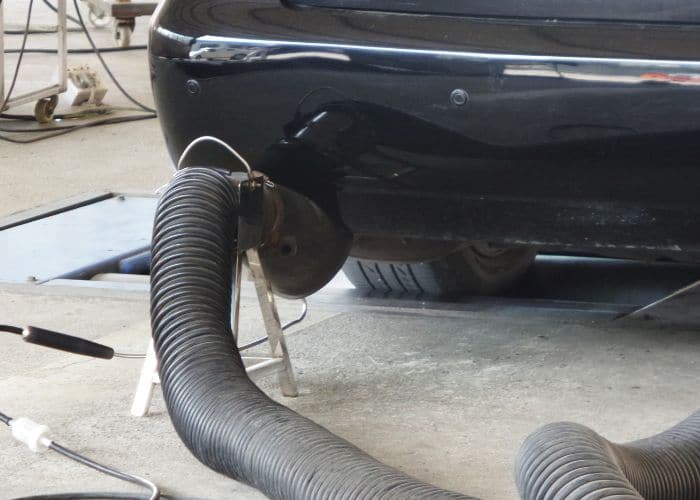The term OBD2 Emissions Test is somewhat of a misnomer because emissions tests are typically conducted as per State or Provincial rules and regulations. Did you know that each state in the United States is free to set their own emissions standards and testing regimes, as well as vehicle safety inspections. We’ve written an article on vehicle safety inspections that you can check out as well. In the meantime, let us explain about OBD2 and how it is an integral part of emissions testing and compliance on modern vehicles.
How can my vehicle pass the OBD2 Emissions Test? The computer control units on modern cars include emissions testing regimes that continually monitor certain parameters and inform the driver of faults. To ensure that your vehicle is in peak condition, you can undertake an OBD2 diagnostic scan, either at a workshop, or on your own. You shouldn’t want until the Check Engine light illuminates to do this, but schedule periodic diagnostic scans. If you desire, you can perform a scan by yourself, using consumer-grade diagnostic solutions such as Carly.
GAIN MORE CONTROL OF YOUR CAR WITH THE CARLY FEATURES
Check the exact pricing of Carly for your car brand!

Fast International Shipping with DHL

14 days adaptor return policy

Excellent customer support

Lifetime warranty in the hardware
SEEN IN
What’s the Link between OBD2 Emissions Tests?

The OBD (On Board Diagnostics) standard was born out of a need to continually monitor emissions of all internal combustion-engined vehicles. In the Seventies, air quality in most metropolitan areas across the United States was terribly choking, and caused multiple respiratory and related conditions among the people. California, one of the worst-hit states enacted Clean Air regulations, and other states followed in its footsteps. The frameworks dictated, and do to this day, that in addition to regular emissions tests by authorized parties, vehicles should have an in-built mechanism to continually monitor their emissions and alert drivers of faults via a fault indicator, what we now know as the Check Engine Light (CEL). In response to this, OBD1 was developed in the Eighties, which is where the phrase OBD2 emissions test may have originated from.
What Happened to OBD1?
OBD1 was not unified, and hence manufacturers started creating their own proprietary ports and protocols around it. This caused major issues for workshops who had to invest in equipment worth thousands of dollars to read out each brand of car that may visit them for work. There were no consumer-grade solutions either, as the cost was simply prohibitive in the Eighties and Nineties, so OBD1 remained the preserve of workshops.
OBD1 was also aging badly as cars became more computerized and complex. The original standard centered around emissions control and monitoring, but as more computer systems were added to cars, to control everything from brakes and suspension to safety systems, climate control, and infotainment, the standard soon became inadequate. An update, as well as a unification, was long overdue.
Enter OBD2

That update came in 1996 with OBD2. A unified protocol that uses a standard 16-pin J1962 connector, OBD2 offered a set of common protocols, as well as manufacturer-specific protocols that each automaker could customize based on the systems installed in their cars. OBD2 emissions tests and testing quickly caught on, as workshops preferred its unified interface, which meant that they didn’t need to invest in multiple pieces of equipment costing thousands of dollars each, that essentially did the same thing. By 2005, every new vehicle sold by a major automaker comes with an OBD2 port. With the prevalence of the EV (Electric Vehicle) future, the OBD3 standard is in development to cater to it.
How Can I Check My Vehicle Emissions via OBD2?

If there is a fault in your vehicle’s computerized control systems, regardless of whether it’s an OBD2 emissions test system fault or other fault, your Check Engine Light (CEL) will illuminate. More sophisticated vehicles from recent years will also pop up a message in their multi-information display, or on the infotainment system screen informing you of a fault. A trip to a competent workshop for a diagnostic scan can help you idenfity the exact issue, and determine what corrective action is required.
However, this avenue is not cheap. The workshop scan for an OBD2 emissions test itself can cost between $30 and $80, and you should add your time cost, as well as cost of fuel spent driving to and from the workshop. Consider that it’s recommended to conduct a diagnostic scan once every three months, and more frequently if your vehicle is a high-miler or older than ten years, and it all adds up. However, there is a way you can do it at home.
How Can I Do It at Home?
Your vehicle’s OBD2 port travels with the vehicle of course, and is easily accessed from the interior. You can find its location via the owner’s manual, or with a quick internet search. Investing in a consumer-grade diagnostic scanning solution allows you to perform diagnostic scans by yourself and identify issues. There are hundreds of solutions available, from dedicated hand-held devices to software that install on laptops, and the type that we’d prefer, an app on your smartphone that wirelessly communicates with a OBD2 dongle or adapter. This is the most versatile avenue; however you should ideally try to purchase a comprehensive solution where the hardware and software are from the same manufacturer. Mixing and matching can result in weak diagnostics, a narrow feature set, and may not work at all. You can purchase an OBD2 adapter for as low as $35, and find free apps to use with it, but your experience will be sub-optimal. We’d recommend Carly, a solution where the hardware and software components have been made by the same party, and extensively tested to ensure perfect functionality and synergy.
What’s Carly?
Carly is a solution that includes the Carly Universal OBD Scanner as the hardware component, and the Carly app as the software component. Both components have been intensively developed and tested to work with each other, and Carly offers a level of reliability and dependability that other solutions struggle to match. Your total outlay for Carly is under $100, and you can try out the Carly lite app to check what’s available for your vehicle before making a purchase. The Carly app also receives regular updates, ensuring that it doesn’t become obsolete in time, which is a major issue with most other apps.
Carly offers powerful diagnostic scanning capabilities that can easily identify issues in your vehicle’s emissions control systems, as well as other systems. Unlike most other apps that present you with technical error codes that appear gibberish to a layperson, Carly presents errors in an easy to understand format, and even goes the extra mile by categorizing them into three categories. Red errors are those that must be immediately addressed, Amber ones need looking at but you can drive for a while, and those you shouldn’t worry about are marked as Green. Carly can thus save you an unnecessary trip to the workshop, allowing you to determine when it’s critical.
Carly also offers exciting ways to customize aspects of your car, known as coding, and is a boon for amateur and enthusiast mechanics since it allows you to re-initialize batteries after installing a new one, reset oil change counters, and perform maintenance-related work. Enthusiasts also enjoy Carly’s real-time monitoring of certain parameters, and the Carly Used Car Check is a great detective to sniff out mileage tampering on a used car that you’re planning on buying.

